* * * * *
“The warm bath
is more conducive to health than any luxury which
can be employed in a
populous city; its beneficial effects are
partially described
as follows:
“The celebrated Count Rumford has paid particular attention to the subject of Warm Bathing; he has examined it by the test of experiments, long and frequently repeated, and bears testimony to its excellent effects. ’It is not merely on account of the advantages,’ says the count, ’which I happen to see from Warm Bathing, which renders me so much an advocate of the practice; exclusive of the wholesomeness of the warm bath, the luxury of bathing is so great, and the tranquil state of the mind and body which follows, is so exquisitely delightful, that I think it quite impossible to recommend it too highly, if we consider it merely as a rational and elegant refinement. The manner in which the warm bath operates, in producing the salutary consequences, seems very evident. The genial warmth which is so applied to the skin in the place of the cold air of the atmosphere, by which we are commonly surrounded, expands all those very small vessels, where the extremities of the arteries and veins unite, and by gently stimulating the whole frame, produces a full and free circulation, which if continued for a certain time, removes all obstructions in the vascular system, and puts all the organs into that state of regular, free, and full motion which is essential to health, and also to that delightful repose, accompanied by a consciousness of the power of exertion, which constitutes the highest animal enjoyment of which we are capable.’
“N.B.: As the Bath is generally occupied on Saturday evenings and Sunday mornings, it is recommended to those who would wish to enjoy the Bath and avoid the crowded moment, to call at other times. The support of the public will be gratefully received and every exertion made to deserve it. For the Proprietor, G. Wright.
“Strangers will
recognise the Bathing House from the front being
extended over two lots
of ground, and the centre basement being
of free-stone.”
* * * * *
The bathtub then was the simple tin sort, on the order of the round English tub. To-day the variety of bathtubs as to size, shape, material and appointments is bewildering; tubs there are on feet and tubs without feet, tubs sunken in the floor so that one goes down steps into them, tubs of large dimensions and tubs of small, and all with or without “showers,” as the purchaser may prefer. Truly the warm baths so highly recommended in Count Rumford’s rhapsody are to be had for the turning of one’s own faucet at any moment of the day or night!
The Count Rumford in question is that romantic figure, born of simple English parents, in New England (Woburn, Mass., 1753), who went abroad when very young and by the great force of his personality and genius, became the power behind the throne in Bavaria, where he was made Minister of War and Field Marshal by the Elector, and later knighted in recognition of his scientific attainments and innumerable civic reforms. There is a large monument erected to the memory of Count Rumford in Munich. He died at Auteuil, France, in 1814.




